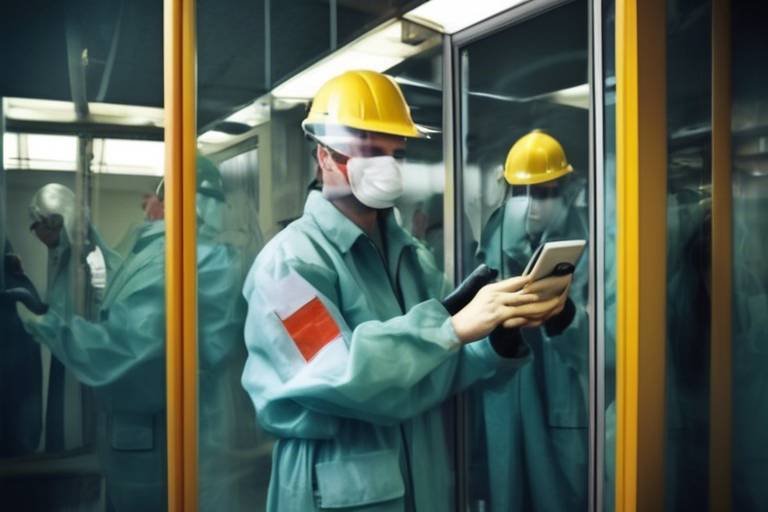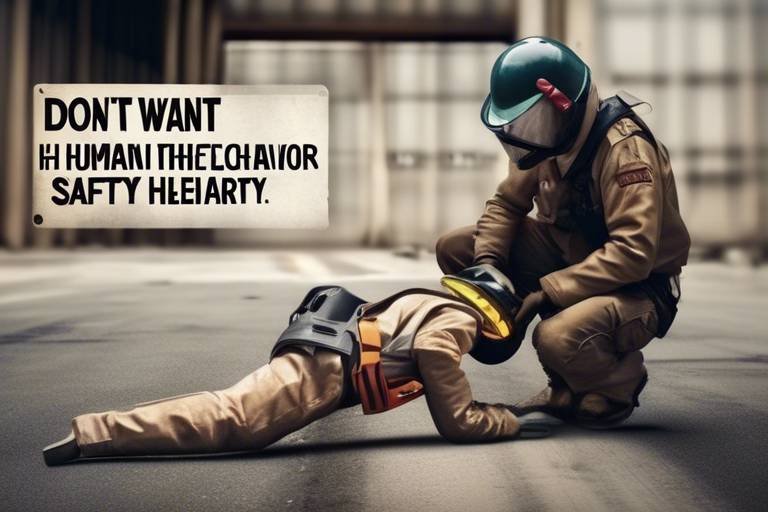The Impact of Human Behavior on Workplace Safety Measures
In today's fast-paced work environment, the importance of workplace safety cannot be overstated. However, have you ever stopped to think about the real driving force behind safety protocols? It's not just about rules and regulations; it's fundamentally about human behavior. This article delves into how our actions, attitudes, and interactions significantly influence safety measures in the workplace. By understanding this dynamic, organizations can create a culture that prioritizes safety, ultimately leading to a healthier and more productive work environment.
Attitudes towards safety can make or break compliance levels within an organization. When employees believe that safety is a priority, they are more likely to adhere to protocols. Conversely, a lackadaisical attitude can lead to negligence and increased risk. It's essential for organizations to recognize how positive and negative attitudes shape behaviors. For example, a worker who feels valued and respected is more likely to take safety protocols seriously. This is why fostering a culture of safety starts with promoting a positive attitude towards it.
Effective training and education programs are crucial in shaping employee behaviors. They serve as the backbone of safety awareness, ensuring that employees are not only aware of safety protocols but also understand their importance. Ongoing training can significantly boost compliance rates and instill a sense of responsibility among workers. Consider this: a worker who has undergone comprehensive safety training is not just following rules; they are equipped with the skills to recognize potential hazards and take proactive measures. Therefore, organizations must invest in continuous training initiatives to keep safety at the forefront of employee minds.
Applying principles of behavioral psychology to safety practices can lead to remarkable improvements in workplace safety outcomes. Understanding how individuals respond to various stimuli allows organizations to design safety programs that resonate with employees. For instance, when workers understand the rationale behind safety measures, they are more likely to comply. This approach goes beyond mere compliance; it fosters a deeper understanding of the implications of unsafe behaviors. By leveraging behavioral insights, organizations can create tailored safety initiatives that effectively engage employees.
Reinforcement techniques, such as rewards and recognition, can serve as powerful motivators for employees to adhere to safety protocols. When organizations acknowledge and reward safe behaviors, they not only reinforce those behaviors but also create a positive feedback loop. Imagine a workplace where employees are celebrated for their commitment to safety; this not only boosts morale but also encourages others to follow suit. Implementing strategies like safety awards or public recognition can significantly enhance compliance and foster a culture where safety is prioritized.
Regular behavioral observations and constructive feedback are essential components of enhancing safety compliance. Monitoring employees' safety practices and providing timely feedback helps them recognize areas for improvement. This process should be viewed as a collaborative effort rather than a punitive measure. When employees receive constructive feedback in a supportive environment, they are more likely to adjust their behaviors positively. Organizations should establish a system for ongoing observations and feedback to ensure that safety remains a shared responsibility.
It’s fascinating how peer interactions can significantly impact individual safety behaviors. The dynamics within teams can either promote or hinder safety compliance. When team members actively support one another in adhering to safety protocols, it creates a collective sense of responsibility. Conversely, a culture where unsafe behaviors are overlooked can lead to a domino effect of negligence. Organizations should encourage open dialogue about safety among peers, fostering an environment where everyone feels responsible for each other's well-being.
Leadership plays a pivotal role in establishing a robust safety culture. Leaders set the tone for safety expectations and can significantly influence employee behavior and commitment to safety measures. When leaders actively engage in safety initiatives and prioritize safety in their decision-making, it sends a clear message to employees: safety is a shared value. This alignment between leadership and safety expectations is crucial for cultivating a culture where safety is embedded in every aspect of the organization.
Leaders who model safe behaviors are instrumental in setting a powerful example for their teams. When employees see their leaders taking safety seriously, they are more likely to emulate those behaviors. This principle of leading by example is fundamental in promoting a strong safety culture. Leaders should not only enforce safety protocols but also participate in safety training and discussions. By demonstrating their commitment, they inspire their teams to prioritize safety as well.
Effective communication is essential for safety success. Leaders must adopt communication strategies that clearly convey safety expectations while fostering an open dialogue about safety concerns. Regular safety meetings, updates, and open-door policies can help create an atmosphere where employees feel comfortable voicing their concerns. When employees know that their voices matter, they are more likely to engage in safety practices actively. This transparency and communication can significantly enhance overall safety compliance.
- What is the most important factor in workplace safety?
While many factors contribute to workplace safety, employee behavior is often the most significant. A culture that prioritizes safety and encourages compliance can dramatically reduce risks. - How can organizations improve safety compliance?
Investing in ongoing training, providing constructive feedback, and recognizing safe behaviors are effective strategies to enhance safety compliance. - What role does leadership play in safety culture?
Leadership is crucial in establishing and maintaining a safety culture. Leaders who prioritize safety and model safe behaviors set a positive example for their teams.

The Role of Attitude in Safety Compliance
When it comes to workplace safety, the attitude of employees plays a crucial role in determining how well safety protocols are followed. Think of it as the foundation of a house; without a solid base, everything else is at risk. A positive attitude towards safety can lead to higher compliance levels, while a negative outlook can create an environment where safety measures are ignored or even ridiculed. So, how do we cultivate a culture of safety that resonates with employees?
One of the first steps is to understand that attitudes are often shaped by experiences, training, and the overall workplace environment. Employees who have witnessed or experienced incidents due to negligence may develop a heightened sense of caution. Conversely, those who have never faced any repercussions for unsafe behavior might adopt a more relaxed attitude. This creates a cycle where positive or negative experiences reinforce a particular mindset towards safety.
To address this, organizations can implement comprehensive safety training that not only covers the "how-to" of safety protocols but also dives into the "why" behind them. When employees understand the rationale behind safety measures, they are more likely to adopt a positive attitude towards compliance. For example, a training session that includes real-life scenarios and testimonials can significantly impact how employees perceive safety. This not only informs them but also emotionally engages them, making safety a shared value rather than a chore.
Moreover, fostering open communication is essential. Employees should feel comfortable discussing safety issues without fear of judgment or reprimand. When leaders encourage dialogue about safety concerns, it cultivates a culture of trust and accountability. This can be achieved through regular safety meetings, anonymous feedback channels, or even casual check-ins where employees can voice their thoughts.
In summary, the role of attitude in safety compliance cannot be overstated. By actively working to shape positive attitudes through effective training and open communication, organizations can significantly enhance their safety culture. This, in turn, leads to a safer workplace for everyone. Remember, a positive attitude is contagious; when one employee embraces safety, it can inspire others to follow suit, creating a ripple effect that strengthens the entire organization.
- How can organizations measure employee attitudes towards safety? Regular surveys and feedback sessions can help gauge employee perceptions and attitudes towards safety protocols.
- What are some effective training methods to improve safety attitudes? Engaging training methods such as interactive workshops, role-playing scenarios, and real-life case studies can significantly improve attitudes towards safety.
- How can leadership influence employee attitudes on safety? Leaders can influence attitudes by modeling safe behaviors, providing consistent communication about safety expectations, and recognizing employees who prioritize safety.

The Influence of Training and Education
When it comes to workplace safety, the phrase "knowledge is power" couldn't be more accurate. The influence of training and education on employee behavior is profound, shaping not only individual actions but also the overall culture of safety within an organization. Imagine walking into a workplace where every employee is well-versed in safety protocols—this is the kind of environment that effective training programs can create. However, the reality is that many organizations overlook the importance of ongoing education, leading to gaps in safety compliance and increased risks.
Training should not be a one-time event; instead, it should be an ongoing process that evolves with the organization and its employees. Regular training sessions can serve multiple purposes: they keep safety at the forefront of employees' minds, update them on new procedures, and reinforce the importance of compliance. For instance, consider the following benefits of continuous training:
- Increased Awareness: Regular training helps employees stay aware of potential hazards and the measures they can take to mitigate risks.
- Skill Enhancement: Ongoing education ensures that employees are not only aware of safety protocols but also know how to implement them effectively.
- Boosted Confidence: Employees who are well-trained are more likely to feel confident in their ability to handle emergencies and adhere to safety measures.
Moreover, training programs should be tailored to suit the specific needs of the workforce. For example, employees in a manufacturing environment may require different safety training than those in an office setting. By customizing training sessions, organizations can address the unique challenges and risks associated with each role. Additionally, incorporating interactive elements—such as simulations and hands-on practice—can significantly enhance learning outcomes. When employees engage with the material actively, they are more likely to retain the information and apply it in real-world scenarios.
Furthermore, the role of leadership in training cannot be understated. Leaders should not only support training initiatives but also participate actively. When employees see their leaders prioritizing safety education, it sends a powerful message about the organization's commitment to a safe workplace. This involvement can foster a culture where safety is viewed as a shared responsibility, further enhancing compliance.
In conclusion, the influence of training and education on workplace safety is undeniable. Organizations that invest in continuous, tailored training programs are likely to see improved safety compliance, reduced incidents, and a stronger safety culture overall. So, the next time you think about cutting corners on training, remember that it’s not just an expense—it’s an investment in the well-being of your employees and the success of your organization.
- What types of training are most effective for workplace safety?
Interactive training that includes hands-on practice, simulations, and real-life scenarios tends to be the most effective. - How often should safety training be conducted?
Safety training should be ongoing, with regular refreshers at least once a year, or more frequently if new hazards or procedures arise. - Can online training be as effective as in-person training?
Yes, online training can be effective, especially when it includes interactive elements and is regularly updated to reflect current safety standards.

When we talk about workplace safety, it’s easy to focus solely on the physical aspects—like equipment, protocols, and emergency exits. But what if I told you that understanding human behavior could be the key to unlocking a safer work environment? This is where behavioral psychology comes into play. By applying the principles of this fascinating field, organizations can significantly improve their safety practices and outcomes.
Behavioral psychology revolves around the idea that our actions are influenced by a myriad of factors, including our environment, experiences, and even our emotions. Imagine a workplace where safety isn’t just a requirement but a deeply ingrained habit. This can be achieved by understanding the psychological triggers that lead to safe—or unsafe—behaviors. For example, if employees feel valued and recognized for their adherence to safety protocols, they are more likely to continue those behaviors. It’s like training a dog; positive reinforcement encourages them to repeat the desired behavior. In the workplace, this means that recognizing safe practices can lead to a culture where safety is prioritized.
Moreover, the concept of cognitive dissonance plays a crucial role in safety compliance. When employees believe in the importance of safety but act in ways that contradict that belief, it creates discomfort. This discomfort can motivate them to change their behaviors to align with their beliefs. Organizations can leverage this by fostering an environment where safety is a shared value, encouraging employees to adopt safer practices to maintain their self-image. It’s a powerful motivator—after all, nobody wants to be the person who jeopardizes their own safety or the safety of others.
Another critical aspect of behavioral psychology in safety practices is the idea of habit formation. Research shows that it takes about 21 days to form a new habit. By consistently promoting safety behaviors through regular training and reminders, organizations can help employees integrate these practices into their daily routines. Think of it as building muscle memory; the more you practice a safe behavior, the more automatic it becomes. This is where ongoing training and education come into play, as they reinforce the importance of safety and help employees internalize these practices.
Additionally, creating a supportive environment where employees feel comfortable discussing safety concerns is essential. When individuals feel safe to voice their worries, it not only fosters open communication but also encourages collective responsibility for safety. This can be achieved through regular safety meetings, anonymous feedback tools, or even safety champions among the staff. When everyone is involved in the conversation about safety, it becomes a shared priority rather than an isolated concern.
In conclusion, applying behavioral psychology to safety practices can transform the way organizations approach workplace safety. By understanding the psychological factors that drive behavior, companies can create a culture where safety is not just a checklist but a fundamental part of the work ethos. So, the next time you think about improving safety measures, remember that it’s not just about the rules—it’s about the people who follow them.
- What is behavioral psychology?
Behavioral psychology is a branch of psychology that studies how people’s behaviors are influenced by their environment and experiences. - How can behavioral psychology improve workplace safety?
By understanding the psychological triggers that influence safety behaviors, organizations can create strategies that promote compliance and a culture of safety. - Why is positive reinforcement important in safety practices?
Positive reinforcement encourages employees to repeat safe behaviors, fostering a workplace culture that prioritizes safety. - What role does communication play in workplace safety?
Effective communication fosters an environment where employees feel comfortable discussing safety concerns, which enhances collective responsibility for safety.

Reinforcement Techniques for Safety
When it comes to workplace safety, reinforcement techniques can be the secret sauce that transforms a simple compliance checklist into a thriving culture of safety. Imagine a garden: without proper care and attention, the plants may wither, but with the right nurturing, they bloom beautifully. Similarly, when organizations implement effective reinforcement strategies, they cultivate an environment where safety is prioritized and valued. This can lead to a significant reduction in accidents and an overall enhancement in employee morale.
One of the most effective ways to motivate employees to adhere to safety protocols is through rewards and recognition. When workers feel appreciated for their safe behaviors, they are more likely to continue those actions. For instance, consider a monthly safety award that recognizes individuals or teams who demonstrate exemplary commitment to safety practices. This not only fosters a sense of accomplishment but also encourages others to follow suit. Here’s a quick look at some reinforcement techniques:
| Technique | Description |
|---|---|
| Safety Awards | Monthly or quarterly awards for individuals or teams that excel in safety practices. |
| Public Recognition | Highlighting safe behaviors during meetings or in company newsletters. |
| Incentive Programs | Offering bonuses or other incentives for meeting safety targets. |
| Peer Recognition | Encouraging employees to recognize their peers for safe behaviors. |
Moreover, feedback plays a crucial role in reinforcing safe behaviors. Regular constructive feedback helps employees understand what they are doing right and where they can improve. This ongoing dialogue not only helps in correcting unsafe practices but also reinforces positive behavior. Imagine a coach giving feedback to an athlete: it’s the guidance that leads to improvement. Similarly, managers should provide timely feedback to their teams, ensuring that safety remains a top priority.
Another effective technique is to create a culture of accountability. When employees know that their actions are being observed and that there are consequences for unsafe practices, they are more likely to adhere to safety protocols. This doesn’t mean creating a punitive environment; rather, it’s about fostering a sense of responsibility among team members. When everyone feels accountable, safety becomes a shared goal, much like a team sport where each player’s performance impacts the whole.
In conclusion, implementing reinforcement techniques for safety isn’t just about following rules; it’s about creating an environment where safety is celebrated and prioritized. By using rewards, recognition, feedback, and accountability, organizations can cultivate a culture that not only values safety but thrives on it. Remember, just like in any relationship, consistency and care are key to nurturing a lasting commitment to safety in the workplace.
- What are reinforcement techniques? Reinforcement techniques are strategies used to encourage and promote desired behaviors, such as adhering to safety protocols in the workplace.
- How do rewards improve safety compliance? Rewards create positive reinforcement, motivating employees to continue safe practices and fostering a culture of safety.
- Why is feedback important for safety? Feedback helps employees understand their performance regarding safety practices, allowing them to improve and maintain safe behaviors.
- What role does accountability play in workplace safety? Accountability ensures that employees take responsibility for their actions, which can significantly enhance adherence to safety measures.

Behavioral Observations and Feedback
In the realm of workplace safety, behavioral observations coupled with constructive feedback serve as vital tools for enhancing compliance and fostering a safety-first culture. It's not just about having safety protocols in place; it's about ensuring that employees understand and adhere to these protocols consistently. When organizations implement regular observations, they can identify both compliant and non-compliant behaviors in real-time, which allows for immediate intervention and support.
Imagine a scenario where a manager notices an employee repeatedly neglecting to wear safety goggles while operating machinery. Instead of waiting for a formal review, immediate feedback can be provided, addressing the behavior on the spot. This proactive approach not only corrects the behavior but also reinforces the importance of safety practices. The key here is that feedback should be specific, timely, and constructive. Employees are more likely to respond positively when they understand exactly what they did well or what needs improvement.
Furthermore, establishing a system for behavioral observations can create a sense of accountability among employees. When team members know they are being observed, they are more likely to adhere to safety protocols. This can be likened to having a fitness buddy; when you know someone is watching your progress, you're more motivated to stay on track. To facilitate this, organizations can implement peer observation programs where employees observe one another's safety practices and provide feedback, fostering a culture of shared responsibility.
Additionally, it's crucial to create a safe space for feedback. Employees should feel comfortable discussing safety concerns without fear of retribution. Open communication channels, such as regular safety meetings or anonymous feedback forms, can encourage employees to voice their observations and suggestions. This not only enhances safety compliance but also contributes to a culture of transparency and trust within the organization.
To further illustrate the impact of behavioral observations and feedback, consider the following table that outlines the benefits of implementing these practices:
| Benefit | Description |
|---|---|
| Increased Compliance | Regular observations help ensure that safety protocols are followed, reducing the likelihood of accidents. |
| Immediate Correction | Timely feedback allows for quick adjustments to unsafe behaviors before they lead to incidents. |
| Enhanced Accountability | Employees take greater ownership of their safety practices when they know they are being observed. |
| Improved Communication | Encourages open discussions about safety, leading to a more engaged workforce. |
In conclusion, the integration of behavioral observations and feedback into workplace safety protocols is not merely a best practice; it’s a necessity. By actively monitoring behaviors and providing constructive feedback, organizations can cultivate a culture of safety that not only protects employees but also enhances overall organizational performance. After all, a safe workplace is a productive workplace!
- What are behavioral observations? Behavioral observations involve monitoring employees' actions to ensure compliance with safety protocols.
- How can feedback improve safety compliance? Feedback helps employees understand their safety practices, encouraging them to correct unsafe behaviors.
- What role does communication play in safety? Effective communication fosters an open dialogue about safety concerns, enhancing overall safety culture.
- Can peer observations be effective? Yes, peer observations create a sense of accountability and encourage safe practices among team members.

Peer Influence on Safety Behavior
When it comes to workplace safety, the power of peer influence cannot be overstated. Imagine a scenario where a new employee is anxious about following safety protocols. They look around and see their colleagues consistently adhering to these measures. This social environment can significantly impact their own behavior, encouraging them to comply with safety standards. Conversely, if they observe coworkers disregarding safety rules, they may feel emboldened to do the same, leading to a dangerous culture of negligence. It's like a ripple effect; one person's behavior can influence another, creating a wave of either safety or risk.
Research has shown that individuals are more likely to engage in safe practices when they are surrounded by peers who prioritize safety. This phenomenon can be attributed to several factors:
- Social Norms: Employees often look to their peers to gauge acceptable behavior. If safety is a norm within the group, individuals are likely to adopt similar attitudes.
- Support Systems: A team that actively supports each other in following safety protocols creates a culture where safety is a shared responsibility.
- Accountability: When team members hold each other accountable, it fosters an environment where safety compliance is expected and valued.
Moreover, the influence of peers can extend beyond just compliance. It can also affect attitudes towards safety training and initiatives. For instance, if a team enthusiastically participates in a safety training session, it can inspire others to engage fully and take the learning seriously. On the flip side, if a few individuals express disinterest or skepticism, it can dampen the enthusiasm of the entire group.
To leverage peer influence effectively, organizations can implement strategies such as:
- Team-Based Safety Programs: Encouraging teams to collaborate on safety initiatives can foster a sense of ownership and collective responsibility.
- Recognition of Safe Behaviors: Publicly acknowledging individuals or teams who exemplify safe practices can motivate others to follow suit.
- Peer Mentoring: Pairing experienced employees with newcomers can help instill a culture of safety from the outset.
In conclusion, the dynamics of peer influence play a crucial role in shaping safety behaviors within the workplace. By understanding and harnessing this influence, organizations can create a more robust safety culture that not only complies with regulations but also prioritizes the well-being of every employee. After all, safety isn’t just an individual responsibility; it's a collective commitment.
1. How can peer influence improve workplace safety?
Peer influence can create a supportive environment where employees feel encouraged to adhere to safety protocols. When team members model safe behaviors, it sets a standard that others are likely to follow.
2. What strategies can organizations use to enhance peer influence?
Organizations can implement team-based safety programs, recognize safe behaviors publicly, and encourage peer mentoring to strengthen the influence of positive safety behaviors.
3. Can negative peer influence affect safety compliance?
Absolutely. If employees observe their peers disregarding safety protocols, they may feel justified in doing the same, which can lead to a decline in overall safety compliance.
4. How important is leadership in managing peer influence?
Leadership is crucial. Leaders who model safe behaviors and actively promote a culture of safety can guide peer influence in a positive direction, reinforcing the importance of compliance and accountability.

The Impact of Leadership on Safety Culture
Leadership is not just about managing tasks; it’s about shaping a culture that prioritizes safety above all. When leaders prioritize safety, it sends a clear message to employees: safety is not just a checkbox to tick off, but a core value of the organization. It’s like a lighthouse guiding ships safely to shore; strong leadership illuminates the path to a safer workplace. The influence of leadership on safety culture can be profound, impacting everything from employee morale to compliance with safety protocols.
One of the most significant ways leaders can affect safety culture is through their commitment to safety practices. When leaders actively participate in safety training and follow safety protocols, they set a standard for others to follow. Employees are more likely to adhere to safety measures when they see their leaders doing the same. This leading by example approach creates a ripple effect, encouraging employees to take safety seriously. It’s not just about saying, "Safety is important"; it’s about demonstrating it through actions.
Moreover, effective communication plays a crucial role in enhancing safety culture. Leaders must foster an environment where open dialogue about safety concerns is encouraged. Employees should feel comfortable voicing their concerns without fear of retribution. This openness can lead to increased reporting of safety hazards and a proactive approach to resolving issues before they escalate. Leaders can implement regular safety meetings or briefings where team members can share experiences and suggestions, further cultivating a culture of safety.
Another impactful strategy is recognizing and rewarding safe behaviors. When employees see that their commitment to safety is acknowledged, it reinforces the importance of adhering to safety protocols. This recognition can take various forms, from simple verbal praise to formal awards. Leaders can create a recognition program that highlights individuals or teams who exemplify safe practices. This not only boosts morale but also encourages others to follow suit, creating a community focused on safety.
Furthermore, leaders should be aware of the influence of their decisions on safety culture. For instance, prioritizing production over safety can send a message that safety is secondary, leading to a culture where employees feel pressured to cut corners. Leaders must ensure that safety is integrated into all aspects of the organization, from planning to execution. This holistic approach ensures that safety is not an afterthought but a fundamental part of the organizational fabric.
In summary, the impact of leadership on safety culture is undeniable. By committing to safety, communicating effectively, recognizing safe behaviors, and making safety a priority in decision-making, leaders can cultivate a robust safety culture that protects employees and enhances organizational performance. The journey to a safer workplace begins at the top, and it’s up to leaders to pave the way.
- How can leaders effectively communicate safety expectations?
Leaders can communicate safety expectations through regular meetings, safety briefings, and by creating an open environment where employees feel comfortable discussing safety concerns. - What are some ways to recognize safe behaviors?
Recognition can include verbal praise, safety awards, or recognition programs that highlight individuals or teams for their commitment to safety. - Why is it important for leaders to model safe behaviors?
When leaders model safe behaviors, it sets a standard for employees, encouraging them to prioritize safety in their own actions.

Leading by Example
When it comes to workplace safety, the phrase "leading by example" isn't just a catchphrase; it's a powerful strategy that can transform the safety culture within an organization. Imagine a workplace where every employee feels empowered to prioritize safety, not because they have to, but because they genuinely want to. This shift in mindset often starts at the top. Leaders who actively demonstrate safe behaviors create a ripple effect that resonates throughout the entire organization.
Leaders have a unique position of influence. When they consistently follow safety protocols, it sends a clear message to employees: safety is not just a priority; it is a core value. For instance, if a manager wears protective gear, follows safety procedures, and encourages others to do the same, it fosters a culture where safety becomes a shared responsibility. Employees are more likely to adopt safe practices when they see their leaders engaging in those very behaviors.
Moreover, leading by example encompasses more than just following safety rules. It also involves open communication about safety concerns and encouraging employees to voice their opinions. When leaders create an environment where feedback is welcomed, it builds trust and accountability. Employees feel valued, and this can significantly enhance their commitment to adhering to safety measures.
Consider this: if a leader is openly discussing near-misses or safety incidents during team meetings, it not only highlights the importance of safety but also normalizes the conversation around it. This proactive approach can lead to a more informed workforce that is better equipped to identify hazards and prevent accidents.
To illustrate the impact of leading by example, let's take a look at a hypothetical scenario:
| Scenario | Leader's Action | Employee Response |
|---|---|---|
| Safety Drill | Leader participates actively and encourages questions. | Employees engage more and share concerns. |
| Incident Reporting | Leader reports a near-miss incident without hesitation. | Employees feel comfortable reporting their own incidents. |
| Safety Training | Leader attends training sessions alongside employees. | Employees see safety as a shared goal. |
In this table, we can see how a leader's actions directly influence employee behavior. By actively participating in safety initiatives, leaders not only enhance their credibility but also inspire their teams to prioritize safety. They become role models, and this can lead to a significant reduction in workplace accidents and incidents.
Ultimately, leading by example is about more than just compliance; it's about cultivating a culture where safety is ingrained in every aspect of the work environment. When leaders embody the principles of safety, they ignite a passion for safety within their teams, resulting in a workplace where everyone looks out for one another. And isn't that the kind of environment we all want to be a part of?
- How can leaders effectively demonstrate safety practices? Leaders can demonstrate safety practices by actively participating in safety training, consistently following safety protocols, and openly discussing safety concerns with their teams.
- What are the benefits of leading by example in workplace safety? Leading by example fosters trust, encourages open communication, and enhances employee engagement, which can lead to a stronger safety culture and reduced incidents.
- Can leading by example impact employee morale? Yes, when leaders prioritize safety, it shows employees that their well-being is valued, boosting morale and encouraging a collective commitment to safety.

Communication Strategies for Safety
When it comes to workplace safety, effective communication is the backbone of any successful safety program. Imagine trying to build a house without a blueprint; it would be chaotic and likely lead to disaster. Similarly, without clear communication, safety measures can falter, putting employees at risk. To cultivate a culture where safety is prioritized, organizations must adopt robust communication strategies that resonate with their teams.
One of the most impactful strategies is ensuring that safety expectations are communicated clearly and consistently. This means not only outlining the safety protocols but also explaining the reasons behind them. For instance, if employees understand that wearing protective gear is not just a rule but a measure to protect their health, they are more likely to comply. It’s like teaching a child to look both ways before crossing the street; when they grasp the 'why,' they are more inclined to follow the 'how.'
Furthermore, fostering an open dialogue about safety concerns is crucial. Employees should feel comfortable voicing their worries or suggestions without fear of retribution. This can be achieved through regular safety meetings where everyone has the opportunity to speak up. Imagine a roundtable discussion where every voice matters; this not only empowers employees but also creates a sense of community focused on safety. A simple approach is to implement an anonymous feedback system, allowing team members to share their thoughts freely.
In addition to meetings, utilizing various communication channels can enhance safety awareness. For instance, digital platforms such as emails, intranet posts, or even dedicated safety apps can serve as effective tools for disseminating information. Visual aids, such as infographics and videos, can also make safety protocols more engaging and easier to understand. After all, a picture is worth a thousand words, and in the context of safety, it can mean the difference between compliance and negligence.
Moreover, leaders should prioritize the use of positive reinforcement in their communication. Recognizing and celebrating safe behaviors can motivate employees to adhere to safety protocols. This could be as simple as a shout-out during team meetings or a safety excellence award. By highlighting the importance of safety and rewarding those who exemplify it, organizations can create a ripple effect that encourages others to follow suit.
Lastly, it’s essential to evaluate and adapt communication strategies regularly. What works today might not be effective tomorrow. Conducting surveys or feedback sessions can help organizations understand the effectiveness of their communication efforts and make necessary adjustments. Think of it as fine-tuning a musical instrument; consistent adjustments lead to a harmonious workplace where safety is prioritized.
- Why is communication important for workplace safety?
Effective communication ensures that all employees understand safety protocols, the reasons behind them, and feel empowered to voice concerns, ultimately leading to a safer work environment. - What are some effective communication strategies for safety?
Clear messaging, open dialogue, use of multiple communication channels, positive reinforcement, and regular evaluation of strategies are all effective methods. - How can leaders foster a culture of safety through communication?
Leaders can lead by example, communicate safety expectations clearly, recognize safe behaviors, and encourage open discussions about safety concerns.
Frequently Asked Questions
- How does human behavior affect workplace safety?
Human behavior plays a critical role in workplace safety. Employees’ attitudes and actions directly influence their compliance with safety protocols. When individuals prioritize safety, it fosters a culture where everyone is more vigilant, leading to fewer accidents and a more secure work environment.
- What is the importance of attitude in safety compliance?
Attitude is everything when it comes to safety compliance. Positive attitudes can motivate employees to follow safety protocols diligently, while negative attitudes may lead to negligence. Organizations can boost compliance by promoting a positive safety culture and encouraging employees to take ownership of their safety behaviors.
- Why are training and education vital for workplace safety?
Training and education are essential because they equip employees with the knowledge and skills needed to recognize hazards and respond appropriately. Ongoing training ensures that safety practices are fresh in employees' minds, reinforcing their importance and helping to create a safer workplace.
- How does behavioral psychology contribute to safety practices?
Behavioral psychology helps us understand how people think and act, which can be leveraged to improve safety practices. By applying its principles, organizations can identify the motivations behind unsafe behaviors and develop strategies to encourage safer practices among employees.
- What are reinforcement techniques for promoting safety?
Reinforcement techniques, such as rewards and recognition, can significantly motivate employees to adhere to safety protocols. When employees are acknowledged for their safe behaviors, it not only boosts morale but also encourages others to follow suit, creating a ripple effect of safety consciousness.
- How can peer influence impact safety behavior?
Peer influence can be a double-edged sword. On one hand, supportive peers can encourage safe practices, while on the other hand, negative peer pressure can lead to unsafe behaviors. Fostering a team environment where safety is a shared value can help mitigate the risks associated with negative influences.
- What role does leadership play in establishing a safety culture?
Leadership is crucial in establishing and maintaining a safety culture. Leaders set the tone for safety practices by modeling safe behaviors themselves. When leaders prioritize safety, it sends a clear message that safety is a collective responsibility, encouraging employees to engage in safe practices.
- How can leaders communicate safety expectations effectively?
Effective communication is key to ensuring everyone understands safety expectations. Leaders should utilize clear, concise messaging and encourage open dialogues about safety concerns. Regular meetings, safety briefings, and feedback sessions can help keep safety at the forefront of employees' minds.



















